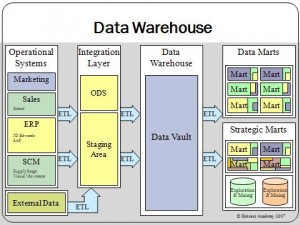Summary: in this article, we will discuss what is the data warehouse, the history of the data warehouse, and its benefits.
What is a data warehouse? Some popular data warehouse definitions
“A warehouse is a subject-oriented, integrated, time-variant and non-volatile collection of data in support of management’s decision-making process”
The terms of the data warehousing definition above are explained as below:
- Subject-oriented: Data in an organization is organized into major objects or business processes. Common examples of subject-oriented data include customer, product, vendor, and sale transactions.
- Integrated: A data warehouse integrates data from various sources across departments within the organization. Different data sources may have different ways of defining specific objects, such as a product. However, in a data warehouse, there must be only one definition of products. This is achieved through name conflict resolution in the data warehouse, ensuring integration.
- Non-volatile: Data in the data warehouse is not subject to change. Once placed in a data warehouse, data is not updated.
- Time-variant: Data in the data warehouse is associated with time. This time dimension can represent a single moment or period. In many cases, the data is only relevant for a specific time frame.
- Support for management decision-making processes: The outcomes of a data warehouse aid in making decisions based on historical data or facts. Through informed business decisions, business processes can be optimized to increase efficiency and effectiveness.
Ralph Kimball defined the data warehouse much more simply in his book “The Data Warehouse Toolkit.” According to Kimball, a data warehouse is “a copy of transaction data specifically structured for query and analysis.” This definition provides less depth and insight than Inmon’s but is no less accurate.
History of data warehouse
The data warehouse was developed in the late 1980s to meet the growing demands for data analysis and information management that couldn’t be achieved by operational systems alone.
Operational systems were primarily optimized for transactions, and as the number of these systems grew rapidly across departments within organizations, data integration became increasingly challenging.
This led to issues such as data redundancy, integration difficulties, analysis hurdles, and performance constraints in reporting.
As a result, a separate system called a data warehouse was designed to solve those problems.
Data warehouse systems can collect data from various source systems, including relational data management systems, flat files, spreadsheets, and even remote data sources outside the organization.
This data is then organized in a way that is optimized for reporting purposes. User-friendly reporting tools provided by the data warehouse system enable business users and decision-makers to access data in the form of useful information with ease.
Data warehouse benefits
There are many benefits that a data warehouse brings to organizations:
- Keep the historical data for analysis even if the source systems do not maintain historical data.
- Allow center point of accessing data across enterprises.
- Improve data quality by cleansing and transforming data when loading it into the data warehouse.
- Give business users or decision-makers “a single version of the truth” i.e. information is presented consistently.
- Provide information instead of data to business users and decision-makers.
- Provide optimized query performance without impacting the operational systems.
- Provide information to improve the business processes.
Summary
In this article, we have:
- Examined Kimball and Inmon’s definitions of a data warehouse
- Discussed the history of data warehousing
- Highlighted the benefits data warehousing brings to organizations
- Directed readers to explore the data warehouse architectures section for a system architecture perspective
